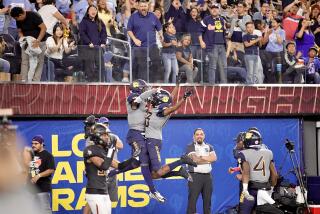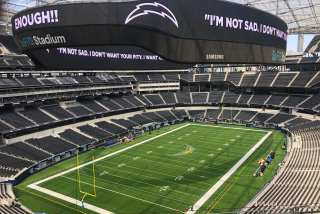S&L; Bailout Laws Saddle Downey With $9.4-Million Loss : Thrifts: The second straight red-ink quarter is a direct result of capital reserve regulations, which forced the still-sound S&L; to set aside $20.7 million. It posted a $13.6-million profit for the year.
- Share via
NEWPORT BEACH — Downey Savings & Loan Assn., scrambling to comply with the tough strictures of the new thrift industry bailout law, on Friday reported a $9.4-million fourth-quarter loss.
Industry analysts and Downey officials, however, said that the loss should be a one-time thing, forced on Downey by new accounting rules and capital requirements. The 33-year-old thrift continues to be financially sound, they said.
Downey in fact posted a full-year profit of $13.6 million despite the sizeable fourth-quarter loss and a $3.7-million loss in the third quarter. The thrift, which has 49 offices in the state, ended the year with $41 billion in assets and a capital base of $219.4 million.
That makes it one of only a few hundred thrifts nationwide that meets or exceeds the three tough new capital reserve requirements established by Congress, industry officials said. In all, there are about 2,800 thrifts in the United States.
Downey’s third- and fourth-quarter losses were direct results of new federal regulations requiring S&Ls; to carry investment properties and securities on their books at or below initial purchase price.
Under the rules, a thrift cannot show an increase in the market value of an investment property but must lower the value or set aside a reserve equal to the drop in value if the market value falls below the purchase price.
The rules also require S&Ls; to set aside reserves to cover a joint venture partner’s potential losses as well.
In Downey’s case, a $20.7-million reserve was established for the fourth quarter to comply with the new rules. That reserve ate up what otherwise would have been an $11-million operating profit for the three-month period.
But the thrift, which has announced plans to divest itself of its $590-million portfolio of shopping centers and other real estate holdings to meet the capital requirements in the next five years, is likely to make up for the losses with profits from the sale of properties, analysts said.
And Downey’s fourth-quarter loss was in keeping with what analysts had predicted, so the thrifts’s stock--which is traded on the New York Stock Exchange--did not lose much value after Friday’s announcement.
Downey common stock closed at $16.88 Friday, down 12 1/2 cents a share in moderately heavy trading.
“The loss for the quarter was less than I thought it would be,” said Michael Abrahams, a thrift industry analyst with the regional brokerage firm of Bateman Eichler, Hill Richards in Los Angeles.
“The regulators are being pretty rough these days, with the seizure of 11 thrifts” Friday, including Mercury S&L; in Huntington Beach and Imperial Savings in San Diego, Abrahams said.
“What we saw with Downey was similar to what happened to some of those others, with the regulators forcing Downey to set up perhaps unnecessarily large reserves,” he said.
“The regulators are trying to show how tough they are,” said Abrahams, “but Downey is one of the best capitalized thrifts around and is well known as one of the classiest acts in the business.”
He said there is no sign that Downey is in trouble or will have to take another significant write-down of the value of its investments.
Campbell Chaney, an analyst with Sutro & Co. in San Francisco, said Downey should do well this year because it won’t have to pay federal income taxes on the first $95 million it earns.
That’s because the thrift has $95 million in operating losses from failed Butterfield Savings in Santa Ana, which it recently acquired, that Downey can use to offset an equal amount of profit.
Gerald H. McQuarrie, Downey’s chief executive and co-founder, said Friday that the thrift must use up the entire $95 million this year or lose it and plans to accelerate the sale of its shopping centers and other investment properties to do so.
“We have five years to sell all of our real estate,” he said, “but we will sell the biggest part of it this year.”
PROFIT AT DOWNEY S & L
In millions of dollars
Quarter Year 1st 2nd 3rd 4th Total 1987 $11.5 $12.3 $5.6 $3.7 $33.1 1988 6.2 4.7 5.2 12.8 28.9 1989 21.0 5.7 -3.7 -9.4 13.6
Source: Downey S&L;
More to Read
Inside the business of entertainment
The Wide Shot brings you news, analysis and insights on everything from streaming wars to production — and what it all means for the future.
You may occasionally receive promotional content from the Los Angeles Times.










